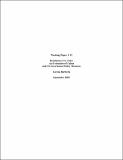| dc.contributor.author | Barberia, Lorena | |
| dc.date.accessioned | 2015-07-01T15:53:46Z | |
| dc.date.available | 2015-07-01T15:53:46Z | |
| dc.date.issued | 2002-09 | |
| dc.identifier.uri | http://hdl.handle.net/1721.1/97606 | |
| dc.description.abstract | Since the commencement of hostilities between Cuba and the US in the early 1960s, both governments have repeatedly attempted to influence private family money transfers across borders. This study undertakes a retrospective assessment of Cuban and US government policy on remittances from 1959 to the present. Tracing policy shifts and targeted outcomes, the paper argues that (1) the aggregate flow of remittances and their uses are highly sensitive to macroeconomic, political, and institutional factors in Cuba, the receiving country, and are less sensitive to the policies imposed by the sending country, the United States; (2) Cuban government policy has been successful in attracting remittances and partially successful in channeling these flows toward the State-controlled economy; and (3) Cuban government policies are encouraging the use of these flows for consumption and less so for savings and direct investment. | en_US |
| dc.language.iso | en_US | en_US |
| dc.publisher | Inter-University Committee on International Migration | en_US |
| dc.relation.ispartofseries | Rosemarie Rogers Working Paper Series;15 | |
| dc.title | Remittances to Cuba: An Evaluation of Cuban and US Government Policy Measures | en_US |
| dc.type | Working Paper | en_US |
